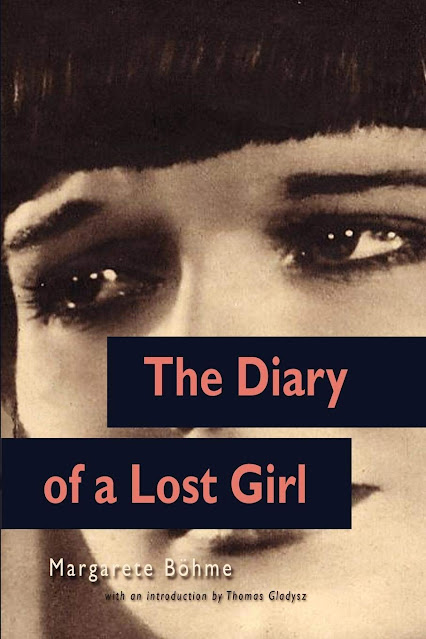Pandora's Box, starring Louise Brooks, was released on this day in 1929. Based on two plays by the German dramatist Frank Wedekind, Die Büchse der Pandora, or Pandora’s Box, tells the story of Lulu, a lovely, amoral, and somewhat petulant showgirl whose behavior leads to tragic consequences. Louise Brooks plays Lulu, the singular femme fatale. As Brooks' biographer Barry Paris put it, her “sinless sexuality hypnotizes and destroys the weak, lustful men around her.” And not just men. . . Lulu’s sexual magnetism had few bounds, and this once controversial film features what may be the screen’s first lesbian character. More about the film can be found on the Louise Brooks Society filmography page.
The film went into production at the Nero-Film Studio in Berlin, with production lasting between October 17 and November 23, 1928. The film premiered on February 9, 1929 at the Gloria-Palast in Berlin, Germany.
Under its original German title, Die Büchse der Pandora, documented screenings of the film took place in Austria, Danzig, Slovakia (then part of Czechoslovakia), Latvia, Luxembourg, Ukraine, and the United States.
Outside Germany, Die Büchse der Pandora was exhibited or written about under the title Loulou (Algeria); La caja de Pandora and Lulu (Argentina); Le boîte de Pandore and Loulou (Belgium); A caixa de Pandora (Brazil); Кутията на Пандора (Bulgaria); La caja de Pandora and Lulu (Chile); Lulu La Pecadora (Cuba); Pandořina skříňka or Pandořina skříňka (Lulu) and Umrít Büchse der Pandoru (Czechoslovakia) and Pandorina skrínka (Slovakia); Pandoras æske (Denmark); De doos van Pandora (Dutch East Indies – Indonesia); Pandora’s Box (England); Pandora laegas (Estonia); Pandoran lipas (Finland); Loulou and Le boîte de Pandore (France); Λούλου and Lulu- το κουτί της Πανδώρας (Greece); Pandóra szelencéje (Hungary); Lulu and Il vaso di Pandora and Jack lo Sventratore (Italy); パンドラの箱 or Pandoranohako and The Box of Pandora (Japan); Korea (Box of Pandora); Pandoras lade and Pandoras Kaste (Latvia); Pandoros skrynia (Lithuania); Lou lou La Boite de Pandore (Luxembourg); La caja de Pandora (Mexico); De doos van Pandora (The Netherlands*); Pandoras eske (Norway); Lulu and Puszka Pandory (Poland); A Bocéta de Pandora and A caixa de Pandora (Portugal); Cutia Pandorei and Lulu and Pandora szelenceje (Romania); Lulu and Pandorina skrinjica (Slovenia); La caja de Pandora (Spain); Pandoras ask (Sweden); Meş’um Fahişe and Meş’um Fahişe (Lulu) (Turkey); Dzieje Kokoty Lulu (Ukraine); Box of Pandora and Pandora’s Box and Pandora szelencéje (Hungarian-language press) and Ящик Пандоры (Russian-language press) (United States); La caja de Pandora and Lulu and El alma de la herrera (Uruguay, sound version); Lulu and Лулу and Ящик Пандорьі (U.S.S.R.); La caja de Pandora (Venezula).
Since the late 1950s, numerous screenings of the film have been taken place around the world, including first ever showings under the title Pandora’s Box in Australia, Canada, India, Israel, Northern Ireland, and elsewhere. Within the last few years, a showing of the film also took place in Turkey under the titles Pandora’nın Kutusu and Pandora’nýn Kutusuö. The film has also been shown on television across Europe as well as in Australia, Canada, the United States, and elsewhere.
*Despite the film being banned in The Netherlands in 1930, it was shown on October 18, 1935 in Amsterdam at De Uitkijk.
— The jazz combo seen playing in the wedding scene in the film is Sid Kay's Fellows. They were an actual musical group of the time. Founded in 1926 and led by Sigmund Petruschka (“Sid”) and Kurt Kaiser (“Kay”), Sid Kay’s Fellows were a popular ten member dance band based in Berlin. They performed at the Haus Vaterland (a leading Berlin night-spot) between 1930 and 1932. And in 1933, they accompanied the great Sidney Bechet during his recitals in the German capitol. Sid Kay’s Fellows also accompanied various theatrical performances and played in Munich, Dresden, Frankfurt, Vienna, Budapest, Barcelona and elsewhere. The group’s depiction in Pandora’s Box predates their career as recording artists. In 1933, when the Nazis came to power, Sid Kay’s Fellows were forbidden to perform publicly. They disbanded, and transformed themselves into a studio orchestra and made recordings for the Jewish label Lukraphon.
— When Pandora’s Box debuted in Berlin in 1929, an orchestra playing a musical score accompanied the film. The score was reviewed in at least one of the Berlin newspapers. The score, however, does not apparently survive. What is also not known is if the music of Sid Kay’s Fellows, or any sort of jazz, played a part in the music of Pandora’s Box. [Interestingly, director G.W. Pabst included another jazz combo in his next film with Brooks, The Diary of a Lost Girl.]































